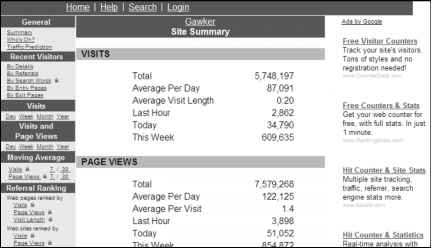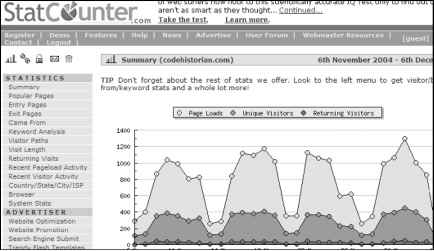Webbased tools
Regardless of your blogging setup, you can always use a Web-based traffic tracker. You place a small piece of JavaScript code on every page on your site, which then reports activity back to the service you're using.
Because these tools require JavaScript to run, they aren't as comprehensive about recording every visit, and they have no way of tracking non-HTML files, such as PDFs and images.
On the other hand, you can track information with JavaScript that just isn't available with log files, including monitor size, DHTML compliance, plug-in status, and more.
Site Meter
Gawker also uses a Web counter from Site Meter (www.sitemeter.com). By using more than one piece of tracking software, Gawker staff can more easily pinpoint discrepancies in site statistics. The free Site Meter services provide basic information about visits and visitors, types of browsers, and referring URLs. It's updated constantly as people come to the site. In exchange, Gawker must display a relatively unobtrusive Site Meter graphic on every page of the site. Figure 7-4 shows Gawker's Site Meter stats. Site Meter's oddly colored tools and cluttered site interface aren't all that appealing to use, unfortunately.
Figure 7-4:
Gawker also uses Site Meter to tracks traffic data.
Figure 7-4:
Gawker also uses Site Meter to tracks traffic data.

As a Site Meter user, you have the option of making your stats public or private. Many blogs have taken to making their stats public; if you're trying to attract advertising and have good traffic, you should consider making these statistics public. For most blogs, there is little point in making this information public.
BraVenet
Counters are only one of the Web tools offered by Bravenet — it also offers hosting, classifieds, chat, site search, and more (but not blog software, unfortunately). It's all free, at least for the basic level of service.
Bravenet offers one stat that isn't always available elsewhere: first-time versus returning visitors. Though it's a suspect number that hits the same limits as other visitor-counting tools, it's still a nice metric to watch change over time.
For an example of this in action, visit counter2.bravenet.com/index. php?id=370586&usernum=137405393. Sign up for Bravenet services at www.bravenet.com.
StatCounter
The nicest thing about StatCounter, better than its clear interface and simple signup, is that you don't need to display a link back to StatCounter, even for the free package. As well, it's a very robust service at a price that can't be beat. StatCounter breaks down your current unique, returning, and repeat visitors, as well as tracks statistics on browser, resolution, operating system, country, search engine, keyword, referring link, and more.
The only limitation on this service is that you must have fewer than 250,000 page views a month to escape paying. More traffic than that, and you need to get out your wallet.
Sign up for StatCounter at www.statcounter.com. There is a good demo of the service available on the site, which you can check out in Figure 7-5.
Figure 7-5:
StatCounter is free for sites with fewer than 250,000 page views a month.
FastCounterPro
Microsoft's Web site traffic tool costs $19.95 a month (as long as you're below 50,000 page views a month) and gives you stats on everything from keywords to conversions to general page view data. Downloadable reports are in CVS format (easy to import into Excel). FastCounterPro is at www.microsoft.com/ smallbusiness/products/online/fs/detail.mspx.
One of the more advanced Web tools, HBX (once known as HitBox) offers an amazing cross-section of tools but is better suited for sites that have large, complex traffic analysis needs. Cost isn't mentioned anywhere on the Web site. HBX is at www.hbxondemand.com.
Figure 7-5:
StatCounter is free for sites with fewer than 250,000 page views a month.

For more site tracking tools, take a look at the Google Directory listing for Counters and Trackers at directory.google.com/Top/Computers/ Internet/Web_Design_and_Development/Hosted_Components_and_ Services/Counters_and_Trackers/.
Use Table 7-1 to help you choose between local tools and Web-based ones. There are always exceptions, but as a general rule, these differences hold true for most site traffic tools.
|
Web-Based |
Local |
|
Works regardless of your hosting |
Need to find a package that works with |
|
limitations |
your host |
|
Your information is stored on |
Keeps your traffic information completely |
|
another company's servers; often |
private |
|
aggregate information is shared | |
|
Has limits on traffic volume unless |
Costs the same regardless of traffic volume |
|
you pay extra |
(usually) |
|
Pay each month |
Pay once |
|
Pay per site |
Pay once |
|
Doesn't track hits for certain file |
Records every Web server hit, regardless |
|
types such as PDFs and Flash |
of file type or visitor's browser |
|
Can slow down your page slightly |
No extra download required |
|
Some visitors object because of the |
Is completely transparent to the visitor |
|
ability to track them from site to site | |
|
May require a visible counter or |
Is completely transparent to the visitor |
|
link to the counter service | |
|
You get upgrades and fixes as |
May not be actively updated; updates may |
|
necessary |
not be free |
|
Live stats usually available |
Usually run once a day or less frequently |
|
Requires code on every page |
No extra page code required (usually) |
|
Installation is extremely simple, |
Installation difficulty varies widely |
|
if you can edit an HTML page | |
|
Same tool can be used if you switch |
Changing hosts usually results in a change in |
|
hosting providers |
tracking; comparing stats becomes difficult |
|
Doesn't include page size data |
Includes page size data — helps you track |
|
your bandwidth usage |
Continue reading here: War blogs and Trent Lott
Was this article helpful?

